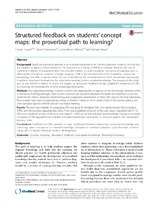| dc.contributor.author | Joseph, Conran | |
| dc.contributor.author | Conradsson, David | |
| dc.contributor.author | Nilsson Wikmar, Lena | |
| dc.contributor.author | Rowe, Michael | |
| dc.date.accessioned | 2018-10-31T09:17:33Z | |
| dc.date.available | 2018-10-31T09:17:33Z | |
| dc.date.issued | 2017 | |
| dc.identifier.citation | Joseph et al. (2017). Structured feedback on students’ concept maps: the proverbial path to learning? BMC Medical Education, 17: 90 | en_US |
| dc.identifier.issn | 1472-6920 | |
| dc.identifier.uri | http://dx.doi.org/10.1186/s12909-017-0930-3 | |
| dc.identifier.uri | http://hdl.handle.net/10566/4172 | |
| dc.description.abstract | BACKGROUND: Good conceptual knowledge is an essential requirement for health professions students, in that they
are required to apply concepts learned in the classroom to a variety of different contexts. However, the use of
traditional methods of assessment limits the educator’s ability to correct students’ conceptual knowledge prior to
altering the educational context. Concept mapping (CM) is an educational tool for evaluating conceptual
knowledge, but little is known about its use in facilitating the development of richer knowledge frameworks.
In addition, structured feedback has the potential to develop good conceptual knowledge. The purpose of this study
was to use Kinchin’s criteria to assess the impact of structured feedback on the graphical complexity of CM’s
by observing the development of richer knowledge frameworks.
METHODS: Fifty-eight physiotherapy students created CM’s targeting the integration of two knowledge domains within
a case-based teaching paradigm. Each student received one round of structured feedback that addressed correction,
reinforcement, forensic diagnosis, benchmarking, and longitudinal development on their CM’s prior to the final submission.
The concept maps were categorized according to Kinchin’s criteria as either Spoke, Chain or Net representations, and
then evaluated against defined traits of meaningful learning.
RESULTS: The inter-rater reliability of categorizing CM’s was good. Pre-feedback CM’s were predominantly Chain structures
(57%), with Net structures appearing least often. There was a significant reduction of the basic Spoke- structured CMs (P = 0.
002) and a significant increase of Net-structured maps (P < 0.001) at the final evaluation (post-feedback). Changes in structural
complexity of CMs appeared to be indicative of broader knowledge frameworks as assessed against the meaningful
learning traits.
CONCLUSIONS: Feedback on CM’s seemed to have contributed towards improving conceptual knowledge and
correcting naive conceptions of related knowledge. Educators in medical education could therefore consider
using CM’s to target individual student development. | en_US |
| dc.language.iso | en | en_US |
| dc.publisher | BMC | en_US |
| dc.rights | © The Author(s). 2017 Open Access This article is distributed under the terms of the Creative Commons Attribution 4.0
International License (http://creativecommons.org/licenses/by/4.0/), which permits unrestricted use, distribution, and
reproduction in any medium, provided you give appropriate credit to the original author(s) and the source, provide a link to
the Creative Commons license, and indicate if changes were made. The Creative Commons Public Domain Dedication waiver
(http://creativecommons.org/publicdomain/zero/1.0/) applies to the data made available in this article, unless otherwise stated. | |
| dc.subject | Concept mapping | en_US |
| dc.subject | Structured feedback | en_US |
| dc.subject | Conceptual knowledge | en_US |
| dc.subject | Meaningful learning | en_US |
| dc.title | Structured feedback on students’ concept maps: the proverbial path to learning? | en_US |
| dc.type | Article | en_US |
| dc.privacy.showsubmitter | FALSE | |
| dc.status.ispeerreviewed | TRUE | |
| dc.description.accreditation | ISI | |

